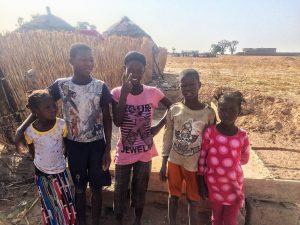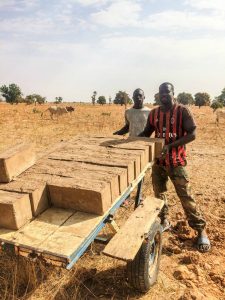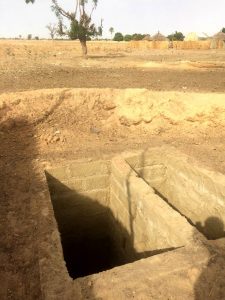This project has been completed under the direction of Peace Corps Volunteer Elizabeth Shariat Panahi. To read about the beginning of the project, CLICK HERE.
The project was to build safe and hygienic latrines in 20 households in Kamatane, and to improve community members’ hygienic practices through training, emphasizing behavior change.
 A summary of Elizabeth’s report is as follows:
A summary of Elizabeth’s report is as follows:
The village of Kamatane is located in the region of Fatick of Western Senegal. Kamatane is a diverse village comprised of Serer, Pulaar, Bambara, and Wolof ethnic groups. There are approximately 900 people in Kamatane’s five neighborhoods.
At the beginning of my service, I conducted a baseline survey in which I found that nearly half of all households (45%) in Kamatane had no latrine and were therefore openly defecating in the surrounding environment, causing high rates of diarrhea and other illnesses in the community. An additional 13% of households had simple latrines with improper construction, making the latrine unsanitary and unsafe, particularly during the rainy season when latrines are likely to collapse and pose serious health issues for the entire community.
Because of this data, I implemented an improved sanitation and hygiene project through the construction of twenty-four latrines by conducting behavior change training sessions, thanks to funding from Water Charity. The latrines were built in four villages: Kamatane Mbar, Bambara, Diamaguene, and Ngamsa.
The number of latrines allocated to each village was decided upon by the health hut committee. The village chiefs then chose which households were to participate based on the household’s level of motivation and ability to contribute both materials and finances.
Members from each household then participated in a behavior change training series. The first session focused on germ theory, illness prevention through hand washing, and construction of tippy taps and handwashing devices. The second session taught latrine repair and prevention of illness through the maintenance of a hygienic latrine. These training sessions consisted of education, interactive demonstrations, and conversational exchanges from the volunteer, trained health workers, and community members.
After the conclusion of the training sessions, the households began to pay their financial contributions and gather the material contributions, including the digging of their pits, collection of sand and water, and transportation of the materials from the local road town into the village. There were challenges in motivating the community during this stage of the process since construction preparation began in November, in which time nearly everyone was busy harvesting their farm crops. However, once field harvest was completed, the households dug the latrine pits quickly and the labor teams were able to begin brick-making and subsequent construction.
A team of brick makers and two teams of masons were in charge of construction and split the labor equally between the initial twenty latrines (which later became twenty-four) so as to allow for faster construction. Construction began in early January and was finished by the end of February. I was very impressed with the speed of the construction phase as well as the ability of my work partners to oversee and manage the project successfully with minimal assistance.
The community is very happy with the outcomes of this project, which is evident in their nearly daily communications to me that they are grateful for the project, and that building a latrine without any financial assistance would not have been possible for them because of its high cost.
In conducting the monitoring and evaluation component of the project, it was found that about half of the twenty-four households built new handwashing stations and consistently wash their hands after using the latrine. I am continuing to work with the remaining households in constructing handwashing stations (a designated bowl and kettle kept near the latrine), and I hope that each household will have one available by the time that I leave (April 2017).
Currently, 127 out of 302 community members report consistently washing their hands with soap and water after using the latrine. Effective behavior change can take years, and I have hope that the community will utilize the knowledge and skills gained through the behavior change components of the project to take control of their health statuses by reducing preventable, sanitation-related illnesses.
Because of this project, there are now over 300 people with access to a safe latrine (that didn’t previously have access) which will significantly reduce the amount of open defecation occurring near the village, and therefore, the prevalence of the diarrheal disease is expected to significantly decrease.
We are grateful to Elizabeth for completing this excellent project.

